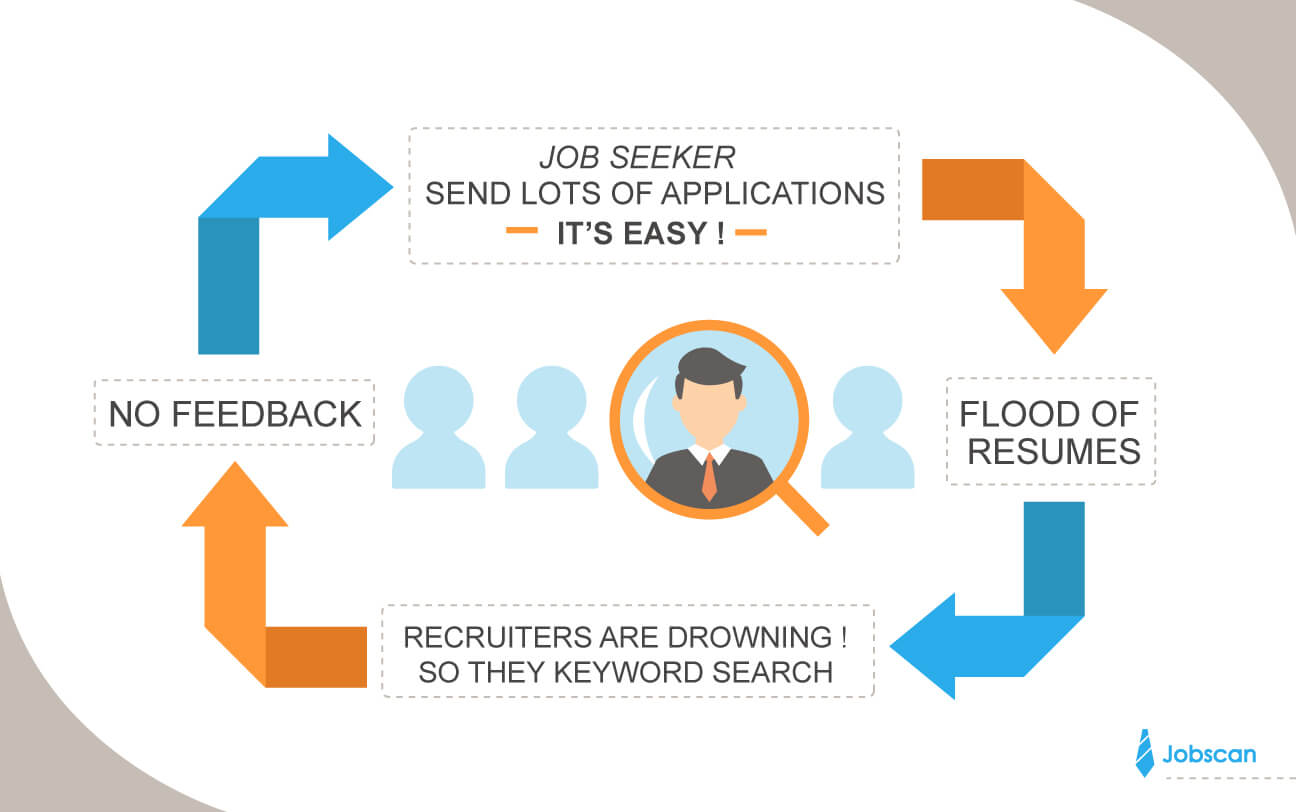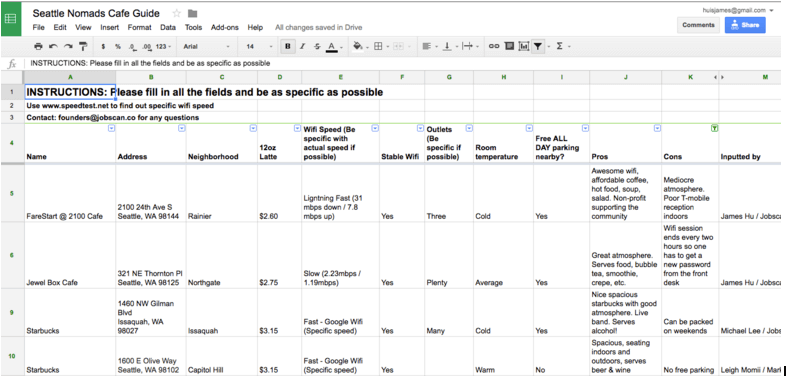I love a good startup story.
The odds are always huge on the personal level, because entrepreneurs have to take lots of risks in order to put their ideas to the test. And they’re fully aware that most startups fail.
So when I was on Skype with Jobscan founders James Hu and Michael Lee, to find out how Jobscan worked, I also asked a few questions beyond the technical stuff. How the idea came about, the pitfalls, the lessons…
Here’s a bit of their story.
The job search problem
It begins in October, 2013, when James was out of a job, coming back from Asia. He was caught in the grueling process of looking for work. He researched how resumes were handled and decided to invest a lot of energy into tailoring keywords. His goal was to convince automated resume screeners that he was a good candidate.
But he felt he was spending too much time, for each application, identifying the right keywords to include in his resume. Such a tedious process! Being a techie, he knew this could be automated, so he got to work on what would become the core “Jobscan” functionality: comparing keywords in your resume with those of the job listing.
Not only would an automated solution improve his job search, it would also become a remarkable part of his portfolio. Two birds with one stone! This was indeed a good project to showcase his technical abilities. So he coded away, by himself.
For about two months and a half, he was using his keyword tool and improving it. The idea of sharing his little app became obvious: “While I was building this, I figured I might as well make it useful to others. Maybe it’s something I could turn into a service one day.”
Once it was relatively bug-free (James and Michael like that term: “relatively”), he started telling his friends. And that’s how Jobscan was launched. In a remote corner of the web, somewhere, without blogger-magnet startup stunts like chocolate-covered grasshoppers or lying about a yoga video… It was just out there, for people to use. And it grew organically. The word got out about this cool new keyword-matching app. (A very decent “minimum viable product”, or MVP, as it’s called in the “Lean Startup” movement in the Silicon Valley.)
In the meantime, James found work. And he’s not the only one that got good results with Jobscan: the feedback he was getting was positive. So he kept going, dug deeper into each ATS, despite working full-time.
A year later, James quit his job and focused solely on Jobscan. The website started picking up more traction and now needed to level up engineering.
Enter Michael. A software engineer who spent 8 years with Google in New York. They met during a street clean-up volunteering event in Seattle. (Yes, it does read like something they would make up.)
In February 2015, we were looking at a healthy, but still quite small project. And now that James and Michael wanted to see it blossom, they did some serious testing (Why It Works). It allowed them to deepen their understanding of how resumes were processed by computers, and to adapt their tool accordingly.
Riding the wave
In the following months, Jobscan was getting more and more attention. Actually, just a few days after launch, they got mentioned on Lifehacker.com. When you’re a startup, that stuff really helps. Each month, new users were coming in. Which meant that James and Michael were working hard to improve it, but were also feeling the pressure of running a legitimate startup.
Here’s James:
“When you work on something that’s not exactly working — a product or service that people don’t really want–, it feels like you’re dragging the project along. You’re just hammering away and you’re not getting traction. This time around, there’s a market force. The product and the users are dragging us along. It’s almost like we’re riding a wave, and the wave is pushing us forward. That’s a nice feeling, but at the same time, there’s an obligation. A pressure to keep doing better.”
James realized that he was surfing that wave while he was employed. That’s when it clicked for him: Jobscan had taken off. It wasn’t a side project anymore. People were really using it!
And the pressures of a real service were kicking in. The two guys were working very closely together, owning the entire project. For Michael, the main programmer, stepping out of his comfort zone used to mean ‘customer support’. But now, he needed to do some marketing and SEO. And had to learn these skills.
Also, in the early days, the two entrepreneurs would personally reply to every single email they received. Now, they had extra hands for that. People they needed to hire and manage and pay…
For a long time, Michael was afraid of the scale of the website. Could it handle the expanding number of users? “We were growing month over month in terms of traffic. But I didn’t really have the background to know when the website would stop working.”
That does sound like a big concern when your website IS your product…
“There were some scary moments… We got to migrate a couple of times (servers, service providers, etc.). Migrations are… fun.”
To handle all that stress, James even started muay thai (martial art from Thailand). Michael enjoys driving around, something he missed out on in his years in NYC.
Now, while this might look like “just another tech startup” story, it’s very different when it’s your story. For example, it wasn’t clear from Day One whether this would actually take off. It was an adventure, far from the paths they were expected to walk. A lot of people around them thought that safe jobs at Google or Microsoft were much better than this little side project.
“What about your 401(k)? And how will you meet a nice young lady if you’re working on this all the time?”
You get the picture.
The purpose of Jobscan
I’ve asked them about the black hole of resumes; that dreadful silence after you’ve sent one, ten or fifty resumes. It’s sort of a hot topic in the job market space, as it deeply resonates with the unemployed. “Why don’t I hear anything back? What am I doing wrong?”
James understands both sides of the coin:
“There’s a technical perspective and there’s a human element. Ideally, recruiters could get back to candidates, to bring a human touch. No one wants to be rejected by a machine or feel ignored. But at the same time, online applications have become so easy that it causes a flood of resumes… which causes recruiters not being able to respond. And then people apply more… It’s a cycle!”

“Our job is to help people know why the black hole exists and how they can improve their chances.”
And that’s really the purpose of Jobscan. They understand how broken the job search process is, especially the lack of feedback. But Jobscan can help you navigate around the black hole (explained here). They’ve tested the impact of tailoring keywords and they know it works.
They’re quite serious about trying to help job seekers. As Michael noted: “We can’t solve the problem completely, because there’s multiple aspects to it. But we can help [job seekers] surface their resumes within the applicant tracking systems.”
And each step forward matters.
Improvement and the Seattle Nomads Café Guide
In the first half of 2015, James and Michael were working out of coffee shops around Seattle. In order to help them choose the right one, they even created a spreadsheet in Google Sheets. But they brought this spreadsheet to another level.
They used the spreadsheet to keep track of each venue and its prices, but also its temperature, number of outlets, wifi speed and free parking availability. And you could sort the list according to your needs!
What’s even funnier is that, when they told me about that spreadsheet, it really wasn’t a big deal for them. (Doesn’t everybody track the number of outlets in their favorite coffee shops?)
I was laughing my head off.

It just illustrates how “optimizing” and “improving” is a natural part of their mindset.
For instance, they’ve recently improved how Jobscan tracks skills, distinguishing among soft and hard skills. They also provide more and more recommendations for your resume, such as scanning for measurable results.
So what does the future hold for Jobscan?
More improvements, of course! They pay attention to user feedback and they’re adamant about always striving for a better product. And while the ultimate vision is building the best tools for job seekers, they remain focused on their core service: providing you with the right resume keywords to get past resume screeners.
* * *
If you’ve been using Jobscan for a while, James and Michael would love to hear your ideas on how to make it better for you. Send them your thoughts at: team@jobscan.co.
About the Author:
Richard Poulin is the founder of Resume Hacking, a website and book series to help job seekers with tailored advice, by profession. One of his big ideas: the 3 laws of resume writing.















